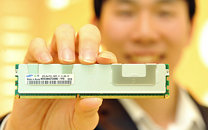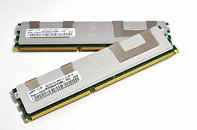- Joined
- Oct 9, 2007
- Messages
- 47,243 (7.55/day)
- Location
- Hyderabad, India
| System Name | RBMK-1000 |
|---|---|
| Processor | AMD Ryzen 7 5700G |
| Motherboard | ASUS ROG Strix B450-E Gaming |
| Cooling | DeepCool Gammax L240 V2 |
| Memory | 2x 8GB G.Skill Sniper X |
| Video Card(s) | Palit GeForce RTX 2080 SUPER GameRock |
| Storage | Western Digital Black NVMe 512GB |
| Display(s) | BenQ 1440p 60 Hz 27-inch |
| Case | Corsair Carbide 100R |
| Audio Device(s) | ASUS SupremeFX S1220A |
| Power Supply | Cooler Master MWE Gold 650W |
| Mouse | ASUS ROG Strix Impact |
| Keyboard | Gamdias Hermes E2 |
| Software | Windows 11 Pro |
Samsung Electronics Co., Ltd., the world leader in advanced memory technology, announced today that it has begun shipping samples of the industry's highest-density memory module for server systems. The 32 gigabyte (GB) module has been designed for use in advanced servers, which require high-density and high-performance features at low-power consumption levels.
According to Soo-In Cho, president and general manager of Samsung Electronics Memory Division, "Samsung continues to set the pace in advanced memory for high-end server applications by offering 40nm-class 32GB memory modules to reach previously unattainable levels of system capacity.In just 10 months, Samsung has now secured the best competitive advantage with the broadest portfolio of 40nm-class DDR3 based memory solutions in the industry since the 40nm-class DRAM was first produced last July."


"Technology leadership is a key factor in Samsung's aggressive competitiveness within the memory industry," Mr. Cho emphasized, "Our highly successful implementation of 40nm-class technology is indicative of our determination to move toward the 30nm-class process node in the second half of this year. Our 30nm-class technology will provide even more advanced memory solutions for high-end server and PC applications".
Samsung is using the industries highest-density monolithic DDR3 device - a 40-nanometer (nm) class, four gigabit (Gb) DDR3 chip - as the building block for the new 32GB module. This comes just one year after the company announced its 50nm-class 2Gb based, 16GB registered dual inline memory module (RDIMM) last March.
The highly-efficient 32GB RDIMM consists of 36 dual-die 40nm-class 4Gb DDR3 chips that can perform at equal or greater levels to a 40nm-based 16GB RDIMM with no increase in power consumption. By equipping a dual CPU, two-way server with 32GB modules, a server system can have up to 384GB of memory. This allows for doubling the previously largest density of 192GBs per server with a power increase of less than five percent over that needed for a 16GB module-based system.
In addition, replacing 12 DRAM modules of 16GB density with just six 32GB modules would achieve a 192GB total density, while allowing the DRAM operating speed in a two-way server system to rise by 33 percent from 800 megabit per second (Mbps) to 1,066 Mbps, as power is cut by 40 percent.
In high-performance, four-way servers using 16GB modules, one terabyte of DRAM would be commonplace.By using 32GB RDIMMs, Samsung is moving toward providing four-way servers with 2TB of DRAM each, a migration that it believes will spur introduction of diverse software and a broader scale of server applications.
Mass production of the 32GB RDIMM is slated to begin next month.
View at TechPowerUp Main Site
According to Soo-In Cho, president and general manager of Samsung Electronics Memory Division, "Samsung continues to set the pace in advanced memory for high-end server applications by offering 40nm-class 32GB memory modules to reach previously unattainable levels of system capacity.In just 10 months, Samsung has now secured the best competitive advantage with the broadest portfolio of 40nm-class DDR3 based memory solutions in the industry since the 40nm-class DRAM was first produced last July."


"Technology leadership is a key factor in Samsung's aggressive competitiveness within the memory industry," Mr. Cho emphasized, "Our highly successful implementation of 40nm-class technology is indicative of our determination to move toward the 30nm-class process node in the second half of this year. Our 30nm-class technology will provide even more advanced memory solutions for high-end server and PC applications".
Samsung is using the industries highest-density monolithic DDR3 device - a 40-nanometer (nm) class, four gigabit (Gb) DDR3 chip - as the building block for the new 32GB module. This comes just one year after the company announced its 50nm-class 2Gb based, 16GB registered dual inline memory module (RDIMM) last March.
The highly-efficient 32GB RDIMM consists of 36 dual-die 40nm-class 4Gb DDR3 chips that can perform at equal or greater levels to a 40nm-based 16GB RDIMM with no increase in power consumption. By equipping a dual CPU, two-way server with 32GB modules, a server system can have up to 384GB of memory. This allows for doubling the previously largest density of 192GBs per server with a power increase of less than five percent over that needed for a 16GB module-based system.
In addition, replacing 12 DRAM modules of 16GB density with just six 32GB modules would achieve a 192GB total density, while allowing the DRAM operating speed in a two-way server system to rise by 33 percent from 800 megabit per second (Mbps) to 1,066 Mbps, as power is cut by 40 percent.
In high-performance, four-way servers using 16GB modules, one terabyte of DRAM would be commonplace.By using 32GB RDIMMs, Samsung is moving toward providing four-way servers with 2TB of DRAM each, a migration that it believes will spur introduction of diverse software and a broader scale of server applications.
Mass production of the 32GB RDIMM is slated to begin next month.
View at TechPowerUp Main Site





